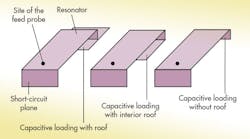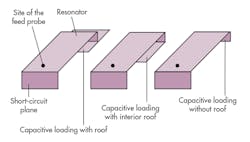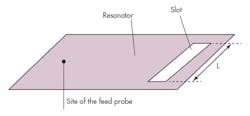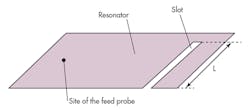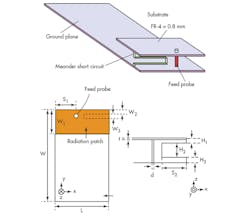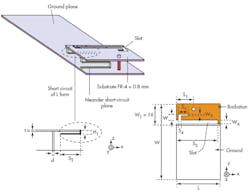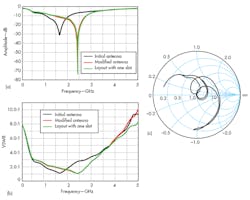Mini Broadband PIFAs Fit Today’s Mobile-Device Designs
This file type includes high resolution graphics and schematics when applicable.
Compact antennas are essential to portable and mobile wireless devices, particularly low-profile antennas that operate reliably. Planar inverted-F antennas (PIFAs) fall into this category, as they can be fabricated in small structures.
When it comes to developing miniature PIFA components for the latest mobile/wireless products, though, there’s the challenge of delivering the wide bandwidths needed to support the devices’ multiple frequency bands. Engineers attacked that problem by applying the formation of slots along with capacitive loading. It led to encouraging results for broadband PIFA design development.
PIFAs have traditionally been too narrow in bandwidth to cover multiple wireless communications bands, prompting investigations into ways to increase PIFA bandwidth. Some of these methods increased the size of the PIFA radiation patch,1 although this increases the size of the antenna. In addition, an impedance bandwidth of 16% was achieved with a PIFA with a T-form ground plane.2 However, this bandwidth is still too narrow for many modern applications, and it may be impractical to produce the required ground plane structure for a realistic antenna product.
Additional approaches to achieving broad bandwidths with PIFA designs included the use of the various feed dishes to widen the PIFA impedance bandwidth.3 Of the various methods attempted, the greatest bandwidth achieved was 24.1% (for a VSWR of less than 2.0:1) for a bi-triangular feed dish. To date, the proposed approaches to increase these bandwidths1-3 have topped out at 25% improvement for PIFA return-loss (S11) performance of better than -10 dB.
Unfortunately, a PIFA requires much wider bandwidth to support today’s popular wireless, mobile applications. For example, for 1710- to 1880-MHz DCS1800, 1920- to 2170-MHz IMT-2000, and 2400- to 2483-MHz wireless local-area networks (WLANs), a PIFA requires approximately 40% bandwidth.4
Make Them Smaller
One way to miniaturize antennas for these applications is to insert capacitive loading in the antenna’s radiating element(s) (Fig. 1). A number of different configurations have been evaluated for this purpose, with varying degrees of success.5-7 The main disadvantage of using capacitive loading relates to the increase in antenna quality factor (Q). This can make adapting an antenna design to a particular application a delicate process, due to reduced bandwidth and radiating effectiveness.
Another miniaturization approach involves adding slots to an antenna’s radiation pattern to produce new resonant frequencies (Figs. 2 and 3). The resonant frequency of half-wave slots is given by:
fr = c/2l,
while the resonant frequency of quarter-wave slots is given by:
fr = c/4l,
where c = the speed of light, and l = the length of the slot (in mm).
Figure 4 shows the structure of the initial antenna design.4 This antenna is composed of a rectangular radiating patch fabricated on low-cost FR-4 printed-circuit-board (PCB) material with a thickness T = 0.8 mm and relative dielectric constant of 4.6. Its dimensions are L = 23.5 mm, W1 = 15 mm, W2 = 2 mm, and S1 = 7 mm.
A coaxial feed probe with diameter d = 1.7 mm and meander short-circuit band are connected to the patch. The meander short-circuit band is fabricated in copper with dimensions of H1 = 2 mm, H2 = 5 mm, H3 = 2 mm, and S2 = 14 mm; copper-band thickness is 0.3 mm. Bandwidth is tied to a dimension of W3 = 2 mm. The short-circuit band is connected to the edge of the surface of the radiating element at one end and to the side of the ground plane at the other end. The chosen ground plane had a width (W) of 62.5 mm and length (L) of 23.5 mm.
This file type includes high resolution graphics and schematics when applicable.
A Different Spin
This file type includes high resolution graphics and schematics when applicable.
The broadband PIFA is based on legacy PIFA designs, although with two key modifications. The first modification added a short-circuit band in L-type form (with H1 = 2 mm and S2 = 14 mm) at the other end of the radiating element, where the patch width W1 = 16 mm. In the second modification, a slot of another form, with dimensions of W4 = 2 mm, W5 = 1 mm, W6 = 3 mm, S3 = 22.5 mm, S4 = 2 mm, and S5 = 4 mm, is inserted into the radiating element (Fig. 5).
Engineers simulated the novel broadband PIFA with CST Microwave Studio computer-aided-engineering (CAE) software from Computer Simulation Technology. The three-dimensional (3D) electromagnetic (EM) simulation software includes time- and frequency-domain solvers in support of different analysis approaches. Figure 6 shows simulations of the PIFA using this software.
Figures 7(a), 7(b), and 7(c) present documentation for the PIFA’s return loss, stationary wave behavior, and input impedance, respectively, for three simulated antenna designs. As evidenced in the figures, the global antenna provides broadband characteristics.
The antenna designs began with a simple broadband PIFA structure having an impedance bandwidth of 61.15% for return loss (S11) of less than -10 dB from 1.08 to 2.109 GHz. Bandwidth was enhanced by simply reforming the PIFA short-circuit band into a meander band. The broadband PIFA can serve applications in 1570- to 1580-MHz Global Positioning Systems (GPS), 1710- to 1880-MHz DCS1800, 1850- to 1990-MHz Personal Communication Services (PCS) systems, and 1900- to 2025-MHz IMT-2000.
The addition of an L-form short-circuit structure improves antenna performance, featuring return loss of -53.04 dB at 2422 MHz. However, the impedance bandwidth antenna, at 55.21%, is less than earlier versions of the antenna for S11 (return loss) of better than -10 dB from 1462 to 2799 MHz. This antenna design, with this wide impedance bandwidth, can cover GPS, DCS, PCS, IMT-2000, and Bluetooth (2400.0 to 2483.5 MHz) applications.
In the modified PIFA designs, insertion of a slot on the radiating element allows the return loss to reach a peak level of -73.37 dB at a resonant frequency of 2442 MHz. The impedance bandwidth is 51.96 dB from 1530 to 2799 MHz, for a VSWR of less than 2.0:1.
The Smith chart plot (Fig. 7(c)) shows that input impedance locations are located at the center of the abacus for the three antenna designs. This indicates good frequency coverage for the target frequency ranges. The PIFA designs employ a coaxial probe as the feed method with effective results across the wide operating bandwidth for these multiple wireless and mobile-communications applications.
Y. Belhadef, Engineer
N. Boukli-Hacene, Engineer
Telecommunications Laboratory, Faculty of Technology, University of Tlemcen, BP 230, Pole Chetouane, 13000 Tlemcen, Algeria; FAX: (213) 43 28 56 85
References
1. Kathleen L. Virga and Yahya Rahmat-Samii, “Low-Profile enhanced Bandwidth PIFA for Wireless Communications Packaging,” IEEE Transactions on Microwave Theory and Techniques, Vol. 45, No. 10, October 1997, pp. 1879-1888.
2. F. Wang, Z. Du, Q. Wang, and K. Gong, “Enhanced-bandwidth PIFA with T-shaped ground plane,” Electronics Letters, Vol. 40, No. 23, 2004, pp. 1504–1505.
3. R. Feick, H. Carrasco, M. Olmos, and H. D. Hristov, “PIFA input bandwidth enhancement by changing feed plate silhouette,” Electronics Letters, Vol. 40, No. 14, 2004, pp. 921–922.
4. P. W. Chan, H. Wong, and E.K.N. Yung, “Wideband planar inverted-F antenna with meandering shorting strip,” Electronics Letters, Vol. 44, No. 6, March 13, 2008.
5. S. Villeger, P. Le Thuc, R. Staraj, and G. Kossiavas, “Dual-band planar inverted-F antenna,” Microwave and Optical Technology Letters, Vol. 38, No. 1, July 2003, pp. 40-42.
6. J. Ollikainen, O. Kivekas, A.Toropainen, and P. Vainikainen, “Internal dual-band patch antenna for mobile phones,” Millenium Conference on Antennas and Propagation, Davos, Switzerland, April 2000, Session 3A9, CD-ROM SP-444.
7. Kathleen L.Virga and Yahya Rahmat-Samii, “Low-Profile enhanced Bandwidth PIFA for Wireless Communications Packaging,” IEEE Transactions on Microwave Theory and Techniques, Vol. 45, No. 10, October 1997, pp. 1879-1888.
This file type includes high resolution graphics and schematics when applicable.
